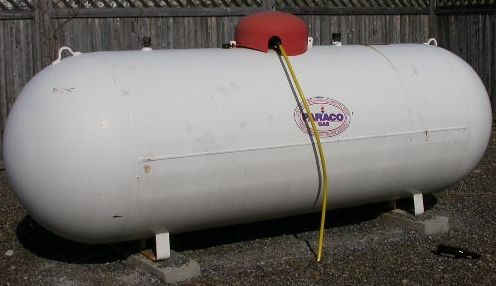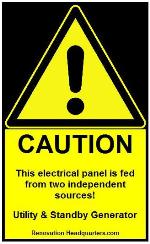Although this is more expensive (the cost of the tank and its installation), than connecting directly to a natural gas pipeline, it provides much better electric power security.
In many cases, especially disasters caused by hurricanes and tornadoes, natural gas pipelines are shut down to avoid fires and explosions in the damaged areas. Having a standby generator without a fuel source, doesn’t accomplish anything.

Figure 4 - Above ground propane tank for a standby generator
An electrical load center (distribution panel) (Figure 5), which has the circuits that will operate when the standby generator is in operation. Some manufacturers of smaller standby generators provide the electrical panel (load center) as an integral part of the transfer switch.

Figure 5 - Load center (distribution panel) for a standby generator
If you are considering the installation of a standby generator there are some considerations:
- Location – the standby generator is noisy and produces carbon monoxide exhaust fumes. Do not place it under a window or close to a door. It is best to place it as far away from the home's physical structure as possible, however you should also take into account the noise level for your neighbors.
- The standby generator should be properly mounted to a concrete pad. The manufacturer of the generator should include pad specifications with the unit. Some of the smaller generators come with an integral pad made of a plastic or composite material. The soil that the standby generator and integral pad are going to sit on should be tamped down, some gravel added and properly leveled.
- Testing – most automatic transfer switches will also provide a pre-scheduled run time once a week for 15 to 20 minutes to ensure that the standby generator is operating. When the generator runs under the automatic transfer switch test mode the load is not switched to the standby generator. It is wise to do a total system check ever three months, this includes switching the load. This involves turning off the main power breaker at the electrical load center (distribution panel), which the system sees as a total incoming power failure and if everything is working correctly the generator will start and transfer the load.
- Maintenance – A standby generator has an engine that is no different than your car. It is important to change the oil, oil filter and air filter at regular intervals. Inspect batteries, fan belts and all connections.
Click on the label, to obtain a full size version, that you can print on label stock and adhere to your electrical panels.

Figure 6 - Standby generator electrical panel warning label.
Warnings:
If you have installed a standby generator and are using an automatic transfer switch you should put warning labels, as shown in Figure 6, on all the electrical panels, stating that turning the main breaker off will not necessarily shut the power down to electrical devices.
Individuals have been electrocuted servicing a home’s electrical system because standby generators have started up and replaced the utility power that was supposedly turned off at the main breaker.
Do not install a standby generator in your home, basement or attached garage. Standby generators exhaust carbon monoxide, which in a strong enough concentration are lethal.
